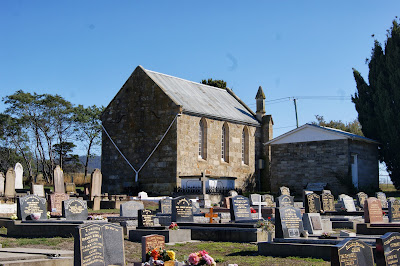Rev. Beasley established a fortnightly service there, which was continued by his successor, Rev. Alex Morison the first Australian student to enter the Congregational ministry. During the pastorate of Rev. Morison, steps were instituted to erect a Chapel at Cambridge, in which to minister to the growing Congregational fellowship. Land on which to build the edifice was generously donated by Mr McRorie, a local landholder.
There are no records concerning the erection of the Church, which traditions claim was designed by the famed convict-architect James Blackburn, who drew plans for the historic Sorell Presbyterian Church about that period of time. Constructed of sandstone, this simple dignified Chapel, located near the modern Tasman Highway, was dedicated and opened for public Worship on Easter Monday, 28th March 1843.
The Church, still in use, though an unpretentious building, embodies history and could not possibly fail to meet the eye of all who travel the busy Tasman Highway.
The first anniversary of the new Church was celebrated on Easter Monday, March 8th 1844. In the presence of a large congregation the officiating Ministers were Rev. J. Bell and Rev. F. Millar. The following year, 1845, special services were held on Easter Monday, March 24th, to observe the second anniversary of the House of Worship. The morning service was conducted by Rev. J. Jarrett, and at 2p.m. Rev. J. Beasley was the celebrant. Collections were made at both services to provide suitable seats for the Chapel.
Even during those early years the Church was subjected to vandalism. Bushrangers spent one night within the hallowed walls while waiting to raid a homestead at Sorell. Their planned raid however was short-lived, police discovered their hiding place, and duly arrested them.
After the departure of Rev. Alex Morison to Melbourne, the Rev. M. Parker took charge of Cambridge, and labored diligently in this service until his death in May 1845. After the demise of Rev. Parker, Cambridge was supplied by the resident minister at Richmond, Rev. William Day, formerly missionary at Samoa. The Chapel at Cambridge was afterwards serviced by successive agents of the colonial Missionary Society, including Joseph Foote, Jesse Pullen, Robert Anderson, Henry D’Emden and Andrew Blackwood who subsequently settled at Hampton Park, Sorell.
Among those early colonists buried in the old Torrens Street Cemetery at Richmond, is the Colonial Missioner, Joseph Foote, who collapsed in the Congregational Chapel at Richmond on July 9th 1848, while preaching the Gospel to his congregation which comprised many convicts. He died the following day.
During September, 1854, Rev. Henry B. Giles, formerly an agent of the London City Mission, took charge of the Cambridge and Richmond stations. His labors at Cambridge were marked by encouraging results, Church services were well attended, a Sabbath school re-established, and a house for the minister erected.
The usefulness of the residence however, was short-lived, within the space of a few years, fire destroyed the building which had been situated east of the Chapel, and within the boundary of the church grounds, leaving only traces of the foundation visible.
After the departure of Rev. Giles, the pulpit of the Cambridge Chapel was shared by various ministers, and Colonial Missionary Society agents until the arrival of Rev. D.B. Tinning at Richmond in 1869. During Rev. Tinning’s twenty years pastorate at Cambridge, the small band that made up the fellowship earned the respect of other Christian denominations and exercised an influence out of proportion to its own congregation. The numbers of folk attending Divine Worship increased until the chapel could not accommodate all who wished to hear the services. This was overcome by the erection of a gallery, situated within the entrance of the Chapel, and no doubt would have provided additional space for the younger members of the congregation, thus assisting the elderly folk to obtain seating in the pews.
After having been closely associated with Richmond during the early years the Cambridge Church, soon after the departure of Rev. Tinning, about 1890 became a preaching place for ministers and laymen residing at Bellerive. These were difficult times for ministers and laymen, as they endeavored to carry out their Christian duties among the scattered congregation. In the main, traveling was done by horse and trap, but on some occasions was restricted to walking long distances to preach the Gospel and visit the sick. In 1924, Cambridge and Richmond became part of the Lindisfarne parish, which at that time was in charge of Rev. W. Owen Lewis, who remained their beloved pastor until his death on 29th January in 1947. His burial took place in the Cemetery near the Chapel at Cambridge.
In June 1956, Cambridge became part of the joint Lindisfarne - Richmond congregations, under the Joint Advisory Council, and some years later, after the Enabling Act had been passed by both Houses of Parliament in Tasmania during May 1971, to provide for Church Union with Presbyterian, Methodist and Congregational Churches, the Cambridge Congregational Church became the Cambridge Uniting Church.
Even after the passing of over one and a half centuries of time, the Chapel has retained its original outward appearance which speaks volumes for the workmanship performed by the stonemasons of yesteryear. The interior also, has lost little of its former glory, excepting the removal of the primitive plaster, which has been replaced with modern pine lining, and the six Gothic windows, each made up of twenty-seven small panes of glass which have been skillfully substituted with perfect replicas of the original.









